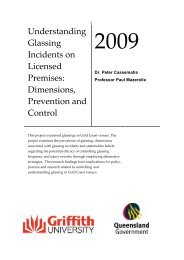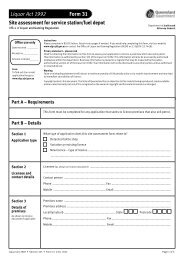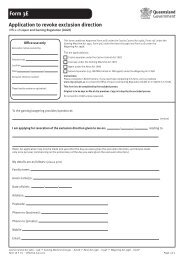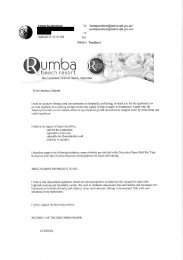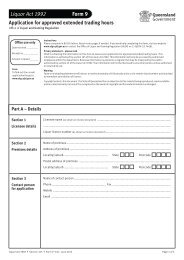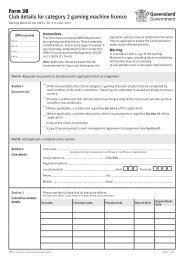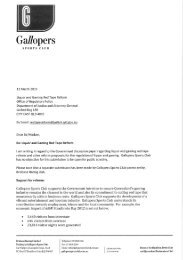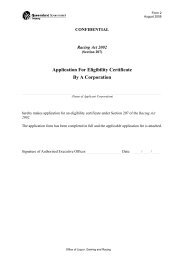Towards Best Practice for Licensed Venues - Office of Liquor ...
Towards Best Practice for Licensed Venues - Office of Liquor ...
Towards Best Practice for Licensed Venues - Office of Liquor ...
Create successful ePaper yourself
Turn your PDF publications into a flip-book with our unique Google optimized e-Paper software.
<strong>Towards</strong> best practice <strong>for</strong> safety in licensed venues<br />
8<br />
<strong>Best</strong> practice<br />
• Impose bans on patrons when it is in the best interests <strong>of</strong> venue safety or <strong>of</strong> the individual(s) concerned.<br />
• Procedures <strong>for</strong> imposing and en<strong>for</strong>cing a ban should be <strong>for</strong>malised and be consistent with the principles<br />
<strong>of</strong> natural justice.<br />
• Group venue ban arrangements should adopt similar <strong>for</strong>mal processes.<br />
• <strong>Venues</strong> must not discriminate when imposing a ban and management should be familiar with the<br />
relevant law.<br />
• Patrons should be in<strong>for</strong>med <strong>of</strong> the venue’s banning practices and procedures including, where applicable,<br />
group venue ban arrangements.<br />
• Where applicable, patrons should be in<strong>for</strong>med that group venue bans involve the personal details <strong>of</strong> the<br />
banned person being given to other venues.<br />
Remember<br />
• Where these best practice principles are inconsistent with a legal standard under the <strong>Liquor</strong> Act or <strong>Liquor</strong><br />
Regulation that specifically applies to your venue, including a condition <strong>of</strong> licence, then you are obligated to<br />
follow that legal standard.<br />
Implementation<br />
In<strong>for</strong>m patrons <strong>of</strong> your banning policy prior to their entry by:<br />
• incorporating the banning policy within the displayed conditions <strong>of</strong> entry or other signage at the door<br />
• promoting the policy in venue advertising or on the venue’s website.<br />
Develop a model to achieve consistency and fairness, <strong>for</strong> example, classifying incidents<br />
Category* Duration <strong>of</strong> ban*<br />
Relatively minor No ban, <strong>for</strong> example: entry refused, asked to leave, banned <strong>for</strong> the day<br />
Unacceptable 1 to 12 months<br />
Serious 1 to 5 years<br />
Extreme 5 years or more<br />
* These are examples only. Adopt or adjust as you see fit.<br />
• When deciding on the category <strong>of</strong> an incident, consider the circumstances and review the evidence<br />
available including:<br />
–level <strong>of</strong> violence or injuries suffered/gravity <strong>of</strong> crime<br />
–level <strong>of</strong> risks and abuse that patrons or staff were exposed to<br />
–CCTV footage and details reported in the incident register<br />
–extent <strong>of</strong> property damage<br />
–previous history <strong>of</strong> poor or unacceptable behaviour/intoxication<br />
–whether staff conduct contributed to the incident.<br />
Develop standards <strong>for</strong> the implementation <strong>of</strong> a ban<br />
• Limit and manage the authority and actions <strong>of</strong> staff to impose bans, <strong>for</strong> example:<br />
–head <strong>of</strong> security or approved manager to issue bans <strong>for</strong> lower category incidents<br />
–licensee or approved manager to issue other bans<br />
–all bans to be reviewed by management<br />
–ban notice to be issued in duplicate and, if possible, copy given to patron.<br />
• A ban notice should include the name <strong>of</strong> venue, name <strong>of</strong> patron, reason <strong>for</strong> ban, the time period <strong>of</strong> the ban,<br />
and the position and contact details <strong>of</strong> the venue’s representative.<br />
• Establish a ban register (using the functions <strong>of</strong> an ID scanner, where applicable) to enable a ban to be<br />
en<strong>for</strong>ced. A ban register should include:<br />
–name and, where possible, a photo (<strong>for</strong> example, from a CCTV or ID scanner)<br />
–duration <strong>of</strong> the ban<br />
–reason <strong>for</strong> the ban.<br />
• Keep personal in<strong>for</strong>mation on banned persons secure as per your privacy policy.



